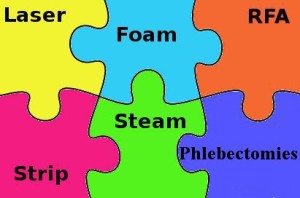There are many different ways of treating varicose veins. These range from surgical operations to strip the refluxing saphenous trunks with phlebectomies under general anaesthesia, to endovenous procedures like foam sclerotherapy, and endovenous thermal ablation (EVTA) with laser, radiofrequency or steam using local anaesthetic. Endovenous thermal ablation is good for refluxing saphenous trunks but painful under local anaesthesia because it requires tumescence. Foam is not that effective in large diameter saphenous veins in obese patients but is less painful and may need to be repeated. Combinations are possible like EVTA to the great saphenous vein with foam to the tributaries, or laser with concurrent phlebectomies, foam for everything or just laser giving the remaining varicose veins an opportunity to regress in some patients. It is clear that one treatment for all is not ideal and patients may be served better using an individual approach.
MARIANNE DE MAESENEER In patients presenting with symptoms and signs of chronic venous disease (CVD) a ‘one size fits all’ strategy is certainly not the most appropriate solution. Instead, a patient-tailored treatment (à la carte) has our preference. In our daily practice at the Erasmus Medical Centre in Rotterdam (Netherlands) we first evaluate the patient’s expectation, complaints and clinical findings. Then we perform a comprehensive duplex ultrasound examination where the ‘duplex anatomy’ and haemodynamics are determined for each individual patient. Even in the presence of a refluxing great or small saphenous vein (GSV, SSV) trunk it is not always necessary to ablate it from the beginning. For example, a more limited surgical approach may be sufficient with small diameter trunks in the absence of focal dilatations with competence of the terminal valve. There is growing evidence that phlebectomies alone, without junction ligation or trunk intervention, may abolish truncal reflux. Therefore, preservation of the saphenous trunks should be considered as a realistic treatment option. This is certainly true for patients presenting with early CVD, which is the case with uncomplicated varicose veins. On the other hand, in patients with clinical class C4-6 and larger refluxing trunks, EVTA (or surgical stripping) under local tumescent anaesthesia will be the treatment of choice. Foam sclerotherapy is often the most appropriate strategy in patients with diffuse varicose vein recurrence.
